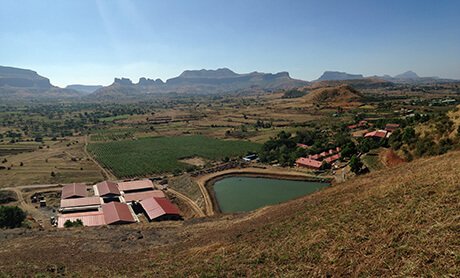The researchers were unable to come to agreement about the exact date of Matsyendranath (who is also called Minanatha), however, in accordance with various opinions, he lived not earlier than 7th century and not later than 12th century. The historical details of his life are lost in the legends that have grown up around him. Most legends about him connect his life with the areas of Bengal, Assam, Nepal and locally near the city Mangalore of Karnataka. A popular legend is that he was swallowed by a fish; and by the sea Lord Shiva was teaching the secrets of yoga (the origin of the Natha teachings) to his consort, Parvati. She fell asleep but he heard everything while hidden in the fish. However he was discovered by them; and Parvati was angry and cursed him to forget all about the yoga. His disciple, Gorakshanath disguised himself as a dancing girl and rescued Matsyendranath from his enchantment through the words of his songs.Another popular belief is that Matsyendranath was created from a fish byLord Shiva who wanted to create him from absolute purity, which could be found in the five elements of life: fire, water, sky, earth and air. Lord Shiva took a certain percentage from each of the five elements and created him. In either of the legends, he has connection to a 'fish' and this is why he had been known as Matsyendranath, "Lord of the Fish". The name also may contain a reference to his occupation: fisherman. It also implies that Lord Shiva himself is considered as the source of the Natha lineage.
Matsyendranath and his disciples spread the Natha, a popular Indian religious movement combining elements of Shaivism, Buddhism, and Hatha Yoga. In the course of time, his name came through numerous distortions, and he became recognized under many different names. His name also appears on both the lists of the 9 Nathas (or masters) and the 84 Mahasiddhas (or great accomplished ones) common to Hinduism and Buddhism. He is the patron of Nepal and was given semi-divine status by his followers and identified with Avalokiteshvara-Padmapani (a bodhisattva or Buddha-to-be) in Nepal, whose other two names LokaNatha (the Lord of the world) and Karunamaya (embodiment of compassion) are also applied to him. In Kathmandu two temples were built in his honor. In Tibet he was known as Lui-pa, which means "fish gut eater"-can be found throughout Northern India. The stories portray him as a yogi fond of eating the innards of fish.
He has wide recognition as the guru of Gorakshanath. Matsyendranatha and Gorakshanath founded the sect known as the Natha tradition (or NathSampradaya) or the Goraknathis or the Kanphata Yogis, an order of religious ascetics who stress the practice of Hatha Yoga.Kanphata - from Kan or ear and phata or split, refers to the fact that during the initiation ceremony the ears are split in order to insert enormous earrings. It is believed that this custom affects an important current (nadi) of life at the ear that facilitates the acquisition of certain magical powers. This order still survives today. The Sanskrit word "Natha" is the proper name of a Hindu initiatory tradition and the word itself literally means "lord, protector, refuge". The related Sanskrit term AdiNatha means first or original Lord, and is therefore a synonym for Shiva, Mahadeva, or Maheshvara. The Natha tradition is a heterodox siddha tradition containing many sub-sects. Matsyendranathand Gorakshanath also revered in Tibetan Buddhism as Mahasiddhas (great adepts) and are credited with great powers and perfected spiritual attainment.
Although it is less known, it is said that he is one of the founders of the Kaula tradition since he is considered as the author of the Kaula-Jnana-Nirnaya ("Discussion of the Knowledge Pertaining to the Kaula Tradition"), one of the earliest texts on Hatha Yoga in Sanskrit. Kaula practices are based on tantra, closely related to the siddha tradition and shaktism. He may have founded the Yogini-Kaula branch. This tantric sect derives its name from its primary doctrinal tenet, the kula. This kula is the ultimate Reality in its dynamic or feminine aspect, as Shakti, specifically kundalini-shakti. The literal meaning of kula is "flock" or "multitude" but also, more significantly, "family" and "home". Thus, the term evokes both the sense of differentiation and protected-ness, which is pertinent in regard to the serpent power, since the kundalini is both the source of the multitudinous universe and the ultimate security for the yogis who knows the kula secret.
Natha is religious movement of India whose members strive for immortality by transforming the human body into an imperishable divine one. It combines esoteric traditions drawn from Buddhism, Shaivism and Hatha Yoga. The term is derived from the names of the nine traditional masters, all of which end in the word natha (master or lord).
The Natha sect consists of yogis whose aim is to achieve sahaja, a state of neutrality transcending the duality of human existence through an awakening of the self's inherent identity with absolute reality. This is accomplished through the practice of kaya-sadhana (cultivation of the body), with great emphasis placed on control of semen, breath, and thought. Guidance of an accomplished guru (spiritual guide) is considered essential.
Phone - +91-9822770727
E-mail - yoga@yogapoint.com or yogapoint108@gmail.com

Yoga Vidya Dham, Kaivalya Nagari,
College Road, Nashik - 422005.
Maharashtra, India.
Phone - +91-9822770727 (for courses in ENGLISH)
+91-253-2318090 (For courses, in HINDI or MARATHI)
(Please call during 9.00 AM to 5 PM Indian Time)
E-mail - yoga@yogapoint.co or yogapoint108@gmail.com
Village Talwade, Trimbak, Nasik
Maharashtra,India.
Phone - +91-9822770727
E-mail - yoga@yogapoint.com or yogapoint108@gmail.com